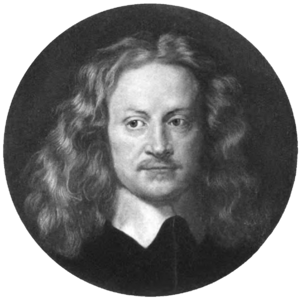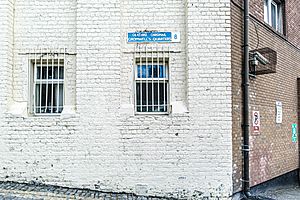Henry Cromwell facts for kids
Quick facts for kids
Henry Cromwell
|
|
|---|---|

Henry Cromwell (1628–1674),
17th century, unknown artist |
|
| Lord Deputy of Ireland | |
| In office 16 November 1657 – 7 June 1659 |
|
| Preceded by | Charles Fleetwood |
| Succeeded by | Edmund Ludlow (as commander-in-chief) |
| Personal details | |
| Born | 20 January 1628 Huntingdon, Huntingdonshire, England |
| Died | 23 March 1674 (aged 46) Wicken, Cambridgeshire, England |
| Spouse | Elizabeth Russell |
| Children | 7 |
| Parents | Oliver Cromwell Elizabeth Bourchier |
| Profession | Politician, soldier |
Henry Cromwell (born January 20, 1628 – died March 23, 1674) was the fourth son of Oliver Cromwell, a powerful leader in England, and Elizabeth Bourchier. Henry played an important role in the government of Ireland during his father's rule.
Contents
Henry Cromwell's Life and Role
Early Years and Education
Henry Cromwell was born in Huntingdon, England, on January 20, 1628. He attended Felsted School and later studied at Emmanuel College, Cambridge.
Joining the Army
Henry joined the New Model Army near the end of the First English Civil War. By 1647, he was either a captain or a commander in a special guard unit. In 1648, he served under his father in northern England.
By February 1650, Henry became a colonel. He followed his father to Ireland with more soldiers. In April 1650, Henry and Lord Broghill won a battle against Lord Inchiquin near Limerick. In 1653, Henry was chosen to represent Ireland in a special parliament called the Barebones Parliament.
Starting a Political Career
In 1654, Henry Cromwell was officially registered at Gray's Inn, which was an honorary title. After the Barebones Parliament ended, his father, Oliver Cromwell, became the "Lord Protector" of England. This period was known as the Protectorate.
Oliver sent Henry to Ireland to find out how the army officers felt about the new government. Henry reported that most of the army was happy with the changes. He also suggested some leadership changes in Ireland.
Leading in Ireland
In August 1654, Henry was appointed commander of the Irish army and a member of the new Irish council. He officially became a council member on December 25, 1654. His father was careful not to seem like he was favoring his sons.
Henry arrived in Ireland in July 1655. His goal was to create a stable government, moving away from military rule. He wanted to help the older Protestant settlers in Ireland. These settlers trusted and admired his leadership.
Henry also worked to ensure fair treatment for different religious groups, like the Presbyterians and Independents. He told religious leaders that they would have freedom, but he would not let any group control the government. His father, Oliver, supported Henry's actions in Ireland.
Henry faced many challenges. He was often sensitive to criticism and sometimes thought about quitting his job. Some soldiers were unhappy with his policies, and some leaders even resigned.
Becoming Lord-Lieutenant
On November 16, 1657, Henry was appointed Lord-Lieutenant of Ireland. This new title gave him more responsibility. However, he still faced difficulties, especially with money. The Irish army's pay was many months late, and the government needed a lot of money from England.
Henry tried to raise money in Ireland, but the country was too poor. Despite these challenges, he managed to keep Ireland peaceful and stable. He believed that his father's government was strong in Ireland.
Henry wanted the Protectorate to be based on strong laws and supported by many people, including former Royalists. He knew that the government's stability depended on his father's life.
After His Father's Death
When Oliver Cromwell died, his son Richard Cromwell became the new Lord Protector. Henry was happy about this, as it kept their family in power. Henry's role as Lord Deputy ended with his father's death, but he soon received a new title: Lieutenant and Governor-General of Ireland.
Henry wanted to return to England to discuss policies with Richard. However, his advisors urged him to stay in Ireland. They believed his leadership there was crucial for his brother's rule in England.

Henry watched the political problems in England with worry. He hoped that the English Parliament would solve the army's issues. When Richard Cromwell's government fell, Henry sent a message saying the Irish army was peaceful. He still saw Richard as the rightful leader.
Royalists, who supported the return of King Charles II, tried to get Henry to help them. But Henry strongly opposed bringing back the Stuarts. He believed that any other problem was better than returning to the old monarchy.
Henry did not want to use his army for his own gain or force its will on the country. After waiting for instructions from Richard, and hearing that Richard had accepted the new changes, Henry submitted to the new English government on June 15, 1659. Parliament then ordered him to leave Ireland and return to England. He arrived in England around the end of June and explained his actions to the council before retiring to Cambridgeshire.
Later Life and Legacy
Henry Cromwell lived a quiet life after his political career. He lost some land in England because of the Restoration of the monarchy. However, he managed to keep an estate he had bought with his army pay.
He asked King Charles II to let him keep his land, explaining that his actions were out of loyalty to his father, not against the king. Many Royalists, including Clarendon, supported him. His lands in Ireland were confirmed to him, but his family later lost them.
Henry lived at Spinney Abbey in Wicken, Cambridgeshire, which he bought in 1661. King Charles II seemed to trust Henry, and he was never bothered by the authorities. Henry Cromwell died on March 23, 1674, at the age of 46, and was buried at Wicken Church.
Family Life
On May 10, 1653, Henry Cromwell married Elizabeth Russell, the daughter of Sir Francis Russell. They had five sons and two daughters. His second son, also named Henry Cromwell, married Hannah Hewling and died in 1711.


